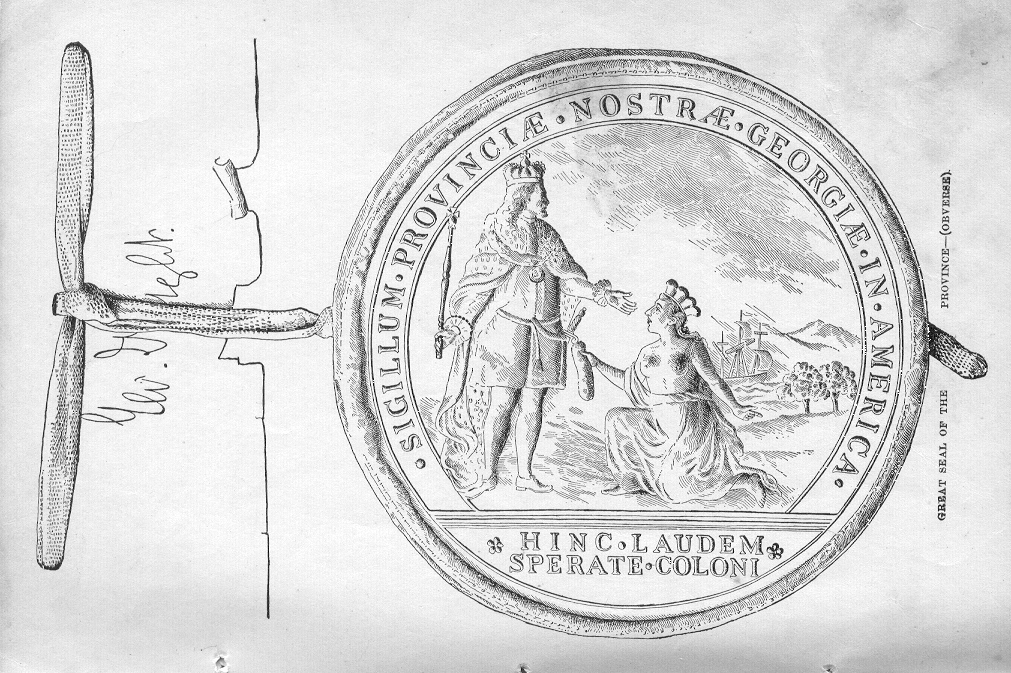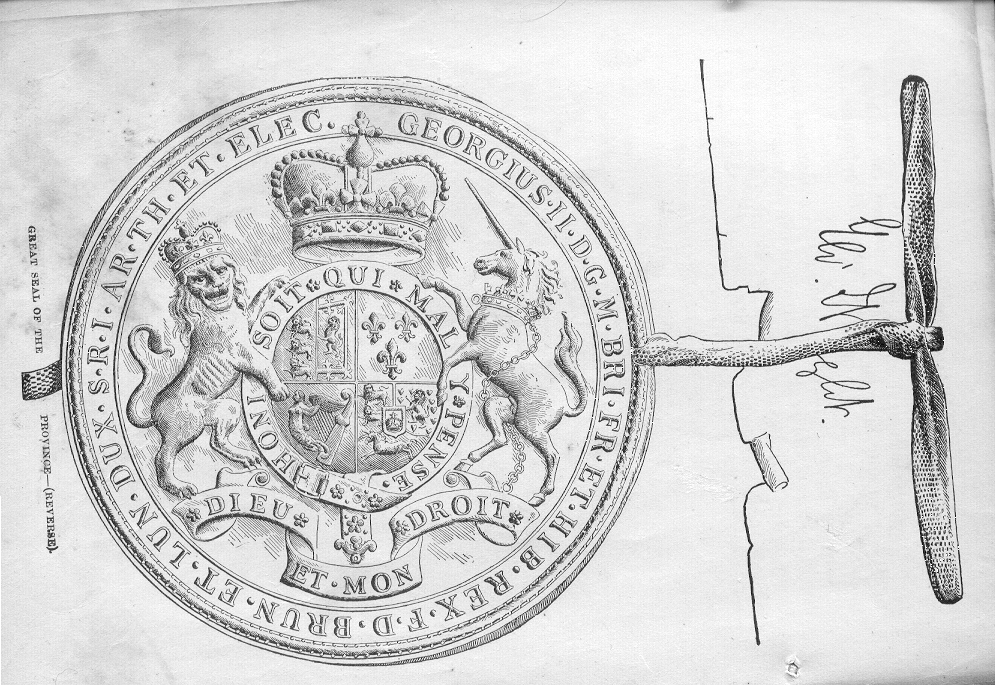

Upon assuming control of Georgia, the king ordered that regulations of the Trustees should remain in force and that the officers then serving should continue in office until the council could agree upon a new form of government. Two years and five months passed before any change was made. Meanwhile President Henry Parker continued in charge of the colony until his death, when Patrick Graham, of Augusta, became president. It was a period of great anxiety to the colonists, who were in doubt as to the future and in continual dread of attacks from the Indians.
There were at that time three forms of government among the English colonies in America. Pennsylvania, Delaware, and Maryland were under proprietors, and were governed as Georgia had been under the Trustees. Rhode Island and Connecticut had charters-that is, written documents from the king, in which he gave them the privilege of electing their own governors and managing their own affairs, so long as they submitted to his supreme authority. The other colonies were called royal provinces, and each had a provincial government, (p51) consisting of a governor and council appointed by the king to represent him, and a lower legislative house elected by the people.
After long deliberation the Lords of the Council finally recommended that Georgia should be raised to the dignity of a royal province. This was approved by the king and in 1754, he appointed Captain John Reynolds of the Royal Navy the first governor of the Province of Georgia.
As a royal province, Georgia was entitled to a great seal. Therefore, on the 21st of June, 1754, the king ordered the dies for the seal to be made of silver and engraved with the design selected as the coat of arms of the new province. These old seals were very curious affairs. They were of wax, as large as a saucer and half an inch thick. When an official document was written and signed, holes were punched in the top of the pages and a piece of tape or ribbon was passed through these holes and tied, so as to fasten the sheets together. The ends of the tape were then placed between two round plates of wax softened by warming, and these pieces of wax were placed between the dies. Pressure was then applied to the upper die, usually by a screw, so as to unite the two plates of wax. After the pressure was removed the dies were taken off, and a single piece of wax was found, bearing on either side in relief the figures that had been engraved on the dies. Such a piece of wax, thus stamped, was the great seal of the Province of Georgia, and was attached to official documents as a proof that they were genuine. The illustrations on the accompanying pages represent one of these seals. They also show a portion of the document, with the holes and the tape, which the seal is attached.
The front of this seal, called the obverse, shows a female figure, representing the young Province of Georgia, kneeling before the king in token of her submission, and presenting him with a skein of silk, while the motto beneath, "Hine laudem sperate coloni" -- meaning, "Hence hope for praise, O colonists!" -- notifies the colonists that the king still expected them to supply him with silk. The Latin words around the circumference mean, "The seal of our Province of Georgia in America." On the other side of the seal, called the reverse, is the coat of arms of George II.
Governor Reynolds arrived in Georgia October 29, 1754. As he landed at the bluff, the people crowded around and welcomed him with joy. At night bonfires were lighted and the houses were illuminated to show the delight of the people upon the arrival of the new governor. He took the oath of office and began his duties at once. His official title was "Captain-General and Governor-in-Chief of his Majesty's Province of Georgia, and Vice-Admiral of the same." He was addressed as "Your Excellency."
No officer in Georgia ever had such a magnificent title or filled so many offices as Governor Reynolds and the other royal governors. As captain-general he had entire control of the militia; as vice-admiral he commanded the naval forces; as governor he had the power of calling together, adjourning, and dissolving the General Assembly at will, and vetoing (that is, refusing his consent to) any bill that was passed by the Assembly. He had charge of the great seal and was chancellor of the province. He presided in the Court of Errors, hearing bills from lower courts, and as ordinary he had charge of the probate of wills and the administration of estates.
The General Assembly consisted of two parts. The smaller body, called the Upper House of Assembly, was made up of twelve members who were appointed by the king. It was also the Governor's Council. The larger body was called the Commons House of Assembly,


and was made up of representatives elected by the people of the several districts of the province to represent them and their wants. Before any bill could become a law it must be passed by both of these houses and be approved by the governor. The Commons House of Assembly, as the representatives of the people, claimed the exclusive right of proposing bills for levying taxes and appropriating money.
Governor Reynolds found the province in a depressed condition, in spite of the bright pictures that had been painted of its prosperity. His first letter to the Board of Trade said: "The town of Savannah is well situated and contains about one hundred and fifty houses, all wooden ones, very small, and mostly old. The biggest was used for the meeting of the president and assistants, and wherein I sat in Council for a few days; but one end fell down whilst we were all there, and obliged us to move to a kind of shed behind the Court-house."
The first legislature of Georgia met in Savannah January 7, 1755. Twelve acts were passed and were approved by the governor. Among them was an act for printing, issuing, and circulating seven thousand pounds sterling in paper bills of credit, which should be legal tender (that is, lawful money) in the province. These paper bills of credit were simply paper money, and were loaned at interest on good security at six per cent in order to supply the people with currency.
Governor Reynolds made a visit to the southern part of the province. He visited Frederica, but found that once lovely city almost in ruins. He journeyed up the Ogeechee River and found a beautiful site for a town. He laid out a town, and named it Hardwicke, after the earl of that name. He proposed to have the capital of the province located here, as it was a more central and beautiful location than Savannah, but the Lords Commissioners did not furnish the money needed to erect public buildings. Governor Reynolds devoted much of his time to improving the forts and defenses of the colony. He went up to Augusta to make a treaty with the Indians. After waiting ten days, during which the Indians did not arrive, he was compelled to return to Savannah. He left presents in charge of his secretary, who delivered them to the Indians and received their assurances of friendship.
The business, which called Governor Reynolds back to Savannah was the arrival of two ships with four hundred Acadians on board. These Acadians were French Catholics from Nova Scotia then called Acadie. Their homes and their churches were burned, and the poor Acadians were driven on board British ships and distributed among British provinces along the Atlantic coast. The reason for doing this was that the Acadians were opposed to British rule. Nothing more cruel and inhuman was ever done by any government. Under the laws of Georgia no Catholic could be admitted to the province, and as these Acadians were Catholics the governor was in doubt what to do. The feeling of humanity prevailed over his respect for the law, and the Acadians were cared for during the coming winter. Most of them left Georgia as soon as possible.
Although Governor Reynolds's administration had begun so pleasantly, it did not prove satisfactory. He became involved in disputes with his Council and with the General Assembly, and much bitter feeling resulted. The people complained to the Lords Commissioners of the Board of Trade and Plantations, and that body, being satisfied that something was wrong, on August 3, 1756, summoned Governor Reynolds to appear before them. He remained in the province until a lieutenant governor could be appointed and sent out to Savannah to relieve him.
[John Reynolds was born in England in 1700. He entered the navy at an early age, and had been advanced to the rank of captain when appointed by the king as the first governor of Georgia. Upon resigning his position he set sail for England to answer the charges made against him. The vessel, in which he embarked was captured by a French privateer, and Reynolds was robbed of his journal, papers, and everything of value belonging to him. After he arrived in London it was nearly a year before he was tried by the Board of Trade. His answers were not satisfactory, however. He then resumed his rank and position in the navy, and before his death he rose to the rank of Rear-Admiral of the Royal Blue. He died in 1776.]
[The initials on the circumference of the coat of arms of George II, stand for the following Latin words: "Georgius II., Dei Gratia Magna Britannia, Francia et Hibernia Rex, Fidei Defensor, Brunsvici et Luneburgi Dux, Sacri Romani Imperii Archi-Thesaurarius et Elector," meaning, "George II., by the Grace of God King of Great Britain, France, and Ireland, Defender of the Faith, Duke of Brunswick and Luneburg, High-Treasurer and Elector of the Holy Roman Empire." The lion and the unicorn with the crown of Great Britain are the coat of arms of the kingdom, and the quarterings on the shield represent the different titles of George II.]
[The first officers appointed for the Province of Georgia were as follows: William Clifton, Attorney-General; James Habersham, Secretary and Register of the Records; Alexander Kellet, Provost Marshal; William Russell, Naval Officer; Henry Yonge and Williams DeBrahm, Joint Surveyors of Land; Sir Patrick Houstoun, Bart., Register of Grants. The members of the first Council were: Patrick Graham, Sir Patrick Houstoun, James Habersham, Alexander Kellet, William Clifton, Noble Jones, Pickering Robinson, Francis Harris, Jonathon Bryan, William Russell, and, subsequently, Clement Martin.]
There were 1325 visitors, at our previous host from 23 Jun 2004 to 9 Aug 2011.
© Copyright 2003 - 2015 - Tim Stowell